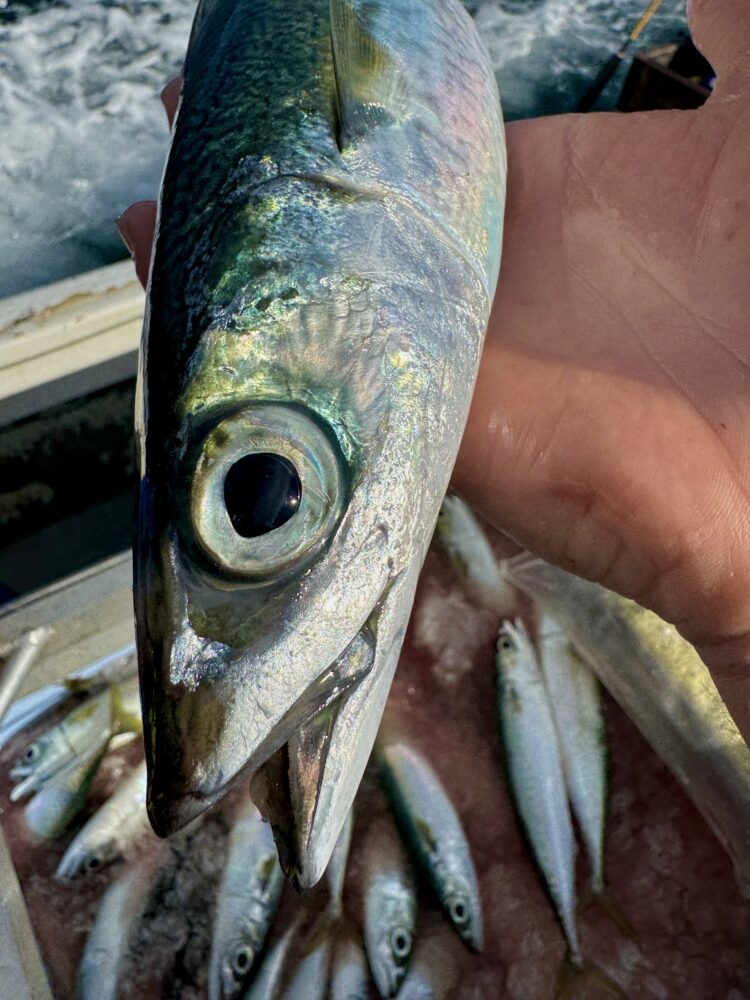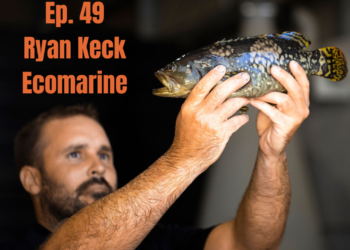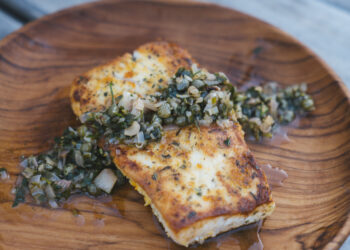CRAIG Lukey and his commercial fishing operation, “SouEast Seafoods” supply some of Australia’s leading restaurants with premium Blue Mackerel. Stationed in the South Coast of NSW in the coastal town of Ulladulla, Craig and his team, including fish butcher Bosley McGee, have carved out a niche market that has taken the seafood world by storm.
The Delicious Produce Awards have had their 20th anniversary, and SouEast Seafoods stole the show in the “From the sea category”. Craig is very proud of the award as it recognises the skill and determination required for him to ship premium Blue Mackerel all over Australia daily. In this article, Craig was interviewed by the On The Sauce Podcast. He describes the nuances of processing this special species of fish.
The Delicious award marks an area of the culinary world that is often overshadowed by the fine dining restaurants and chefs who prepare their produce. It is a great opportunity to give flowers to the primary producers that are making sustainable choices, developing a premier product and reshaping the heavily scrutinised commercial fishing profession.

PHOTO: Bosley McGee
The Slimy
The Australian recreational fishing community has ruled the Blue (Slimy) Mackerel out as a table fish by labelling and stereotypes. Personally, anything slimy isn’t high on the pecking order on my grocery list. Globally, sardines, anchovies and blue mackerel are among the most highly regarded and respected eating species.
If people deferred from the major target species to harvest, and regularly chose to eat their “bait”, it would bring increased balance to an ecosystem that is placed under immense pressure.
Restaurants such as Josh Niland’s St Peter in Paddington have demonstrated the value of these highly abundant species of fish. When treated with care and cooked using compatible techniques, there are few fish that can rival the Blue Mackerel for their eating qualities. Their high oil content means that they are also richer in Omega-3 healthy fatty acids than most other fish.

PHOTO: Bosley McGee
Catching bait
Finding where the bait is holding is the first hurdle. It changes all the time based on currents, moon phases and tides. So having a variety of spots that you can check will increase your strike rate. The pressure edges of reefs are where the bait tends to hold due to the flow of fresh nutrients.
Catching bait like slimies to upgrade to larger species is the primary use for recreational fishers. Bait can be tricky to find at times, but usually easier than the target species. The bait grounds are generally close to the coast and require less fuel to access. Sometimes they can even show up at your local jetty. Not to mention the simple means needed to catch them. Elaborate rods, lures and techniques are overkill. Budget friendly handlines with a single hook and bait are ideal. Or for efficiency, a bait jig with multiple hooks and flashers that reduce the need for bait.
Craig uses a pole and a small single hook to catch his Blue Mackerel, especially when they are feeding off the surface. Without the ability to take drag, the fight times are limited, restricting the buildup of lactic acid. Landing the fish, they go straight into an ice slurry without being touched. Restaurants expect that their fish are presented like they have just come out of the ocean, and this is the best way to do that. Using a bait jig can increase the time taken for the fish to be dispatched and, in worst case scenarios, lead to tangles.

PHOTO: Bosley McGee
Dispatch methods
Craig has used trial and error over the past four years to refine how these fish are presented. Blue Mackerel are a much smaller fish and are delicate, therefore require a unique methodology and care.
Blue Mackerel are constantly swimming in the open water and are not residential. Everything wants to eat them. They are an ideal prey because of their oil content, tiny scales and lack of sharp fins. Yellow Tail or Yakkas are a more hearty live bait, but don’t seem to catch as many fish as the preferred Slimies. If a slimy is bruised, trolled for too long or overhandled, it will perish much faster than a yakka.
Craig carefully considers their characteristics when dispatching his catch. For most customers, he releases his Mackerel straight into a precisely temperature regulated salt water ice slurry. The salt content in the water decreases the freezing point, so it is important that the slurry is not too cold, as this can impact the colour and longevity of fish.
My research to date has found that most species of fish are elevated with dispatch techniques including Ike Jime, Shinkei Jime and deliberate bleeding. Craig, working alongside Australia’s best chefs, has found that skipping these processes has produced a better overall product to cook, specifically for the Blue Mackerel. The flavour profile of the fish is enhanced by keeping it intact. Plus there is less handling of the delicate flesh required. It is important yo remove the contents of the gut cavity as soon as possible to avoid spoilage.
Just like cooking lobster or mud crabs, placing them in the freezer sends them to sleep before cooking. It is more humane but also keeps their limbs in tack when aggressively boiled. Due to the size of the Blue Mackerel and their fragile nature, being placed directly in the slurry has denatures their metabolism in a relatively pain free environment. The Blue Mackerel aren’t touched, ensuring the scales remain intact and there is no bruising, which can spoil the flesh, leading to a mushy texture.
Craig has tried implementing other strategies, but this simple process has produced the best results. He has one client, “Sushi Oe” an amazing Japanese restaurant run by Toshihiko Oe in Sydney. They have requested that their Blue Mackerel be bled. Craig achieves this efficiently by snapping the neck and allowing the arterial blood to squirt out. The Japanese market has requested the fish to be handled in this manner specifically for sashimi purposes. The majority of the restaurants SouEast supplies will cook their Blue Mackerel, hence the nuance.

PHOTO: Bosley McGee
Cooking techniques
If you are looking to explore Blue Mackerel as a staple, I suggest trying sashimi and cooked techniques. Sushi Oe, has a variety of dishes that they prepare with the Blue Mackerel. One of the types of raw fish they serve leaves the skin on with a slightly scored skin. Again, trying new things may open your eyes to something you would have never thought to be tasty.
Bosley McGee is a wizard with a knife. He reverse butterflies Blue Mackerel and removes the bones with tweezers. His knife work takes care of the bloodline. The skin remains on and protects the flesh when cooked over the open coals or flame. Some chefs only cook on the skin side, and others use a fine mesh basket to be able to flip without touching and damaging the fish.
Ideally, the skin is charred through the high heat of cooking. However, if you have not dried the fish properly leading up to cooking this can prove difficult. Thoroughly dry the fish out in the fridge overnight or for around 6 hours to allow the circulating air to dry the skin. Using paper towel to remove any excess moisture before heavily seasoning the skin will promote the crispy texture desired.
Referring back to the delicate nature of Blue Mackerel, there is a fine line between under and overcooking this species. It is better to err on the lesser side, after all, they are an exceptional raw eating fish. Pink in colour and translucent is preferred over completely opaque and white. Using a fish weight can assist to evenly distribute the heat onto the flattened fish. The fish weight will also heat up start cooking the flesh on the other side.
A key to highlighting the flavour of the Blue Mackerel is the use of a premium olive oil to dress the finished product. Apply a generous layer over the fish to serve. A page out of our Mediterranean friends’ book, who have one of the healthiest diets. Oily fish and raw olive oil are crucial components.
SouEast Seafoods has been utilising the natural oils of the Blue Mackerel to smoke batches of fish that are soon to hit the market. Submerging the fish in a saltwater brine is essential. There are plenty of different recipes online if you want to get creative. The end results speak for themselves. Check in with their social media for more information.
Unlike some larger fish, where dry ageing can lead to improved flavour profile up to weeks after their capture, Blue Mackerel are best eaten in the 2-3 days post catch. Craig has refined his processing and packing to a fine art; restaurants all over Australia receive their catch on average 18 hours after it is captured. A remarkable turnaround to optimise the cooking window of the humble Blue Mackerel.
Stocking trends
In NSW, the quota for taking Blue Mackerel has been increased. The numbers are steady which is a positive sign for the future locally. However, more widely in the Commonwealth and overseas fisheries, the numbers are less promising.
The main culprits are big businesses taking huge quantities destined for fertilisers and pet foods. Netting Blue Mackerel damages their fragile frames beyond use for human consumption. It is up to the consumer to ensure they are purchasing local fish that have been caught using line techniques as opposed to netting. Also, to avoid products that are developed with the mass extraction of such a crucial species in the food chain.
There you have it… If you are someone who often comes home empty handed this may be your ticket to success. But everyone should be giving it a go. My two year old child loves them, and that is enough for me to look at them through a different lens.





















